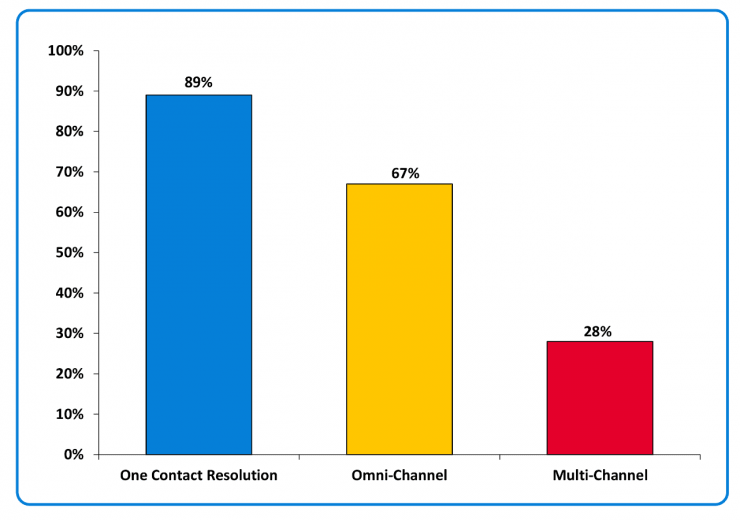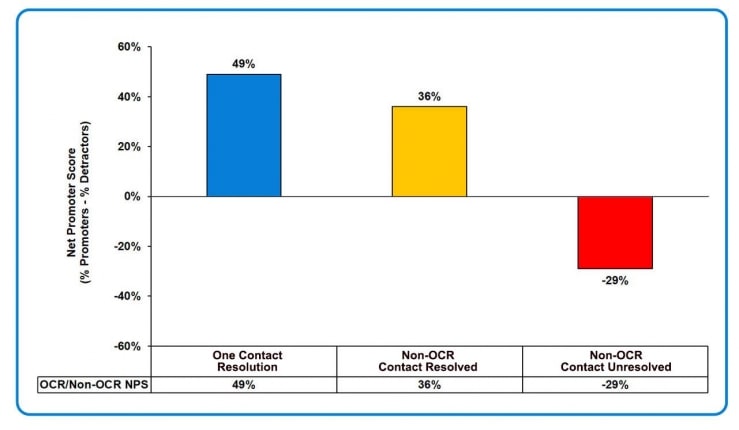
Multi-Channel & Omni-Channel Customer Experience Difference
The vast majority of organizations state that they are trying to improve their customer experience (CX) using contact channels to resolve an inquiry or problem. However, SQM Group's experience shows that few organizations measure customer satisfaction using contact channels (e.g., IVR self-service, mobile self-service, email, and chat) or multiple contact channels to resolve the same inquiry or problem.
Interestingly, SQM research shows that 37% of customers use two or more contact channels simultaneously to resolve an inquiry or problem, and 20% of customers who used a call center did so because a self-service contact channel failed. As a result, SQM is often asked, "What are the customer experience differences between one contact resolution (OCR), multi-channel, and omni-channel from a customer satisfaction (Csat) and recommendation point of view?"
To answer those questions, SQM conducted a Contact Channel Customer Experience Study. We surveyed over 1 million customers who used a contact channel or multiple contact channels to resolve the same inquiry problem. At SQM, we define multi-channel as a non-seamless customer experience for a customer using two or more contact channels for resolving the same inquiry or problem.
In other words, the customer had to start their interaction from the beginning each time they used another channel to resolve the same inquiry or problem. Therefore, we define omni-channel as a seamless customer experience using two or more contact channels for resolving the same inquiry or problem. Put differently, when a customer used another channel to resolve the same inquiry or problem, they were able to pick up from where they left off in the previous channel and, as a result, did not have to start from the beginning.
One of the main findings of our contact channel customer experience research study is that the easier it is for a customer to resolve their inquiry or problem, the higher the customer satisfaction. That is why the OCR customer experience has the highest Csat (89%) by far of all the contact channel experiences (i.e., OCR, omni-channel, and multi-channel) a customer has for resolving an inquiry or problem.
SQM considers 85% or higher Csat (top box response) to be at the world class Csat level for contact channel experience for resolving an inquiry or problem. However, only 5% of SQM's clients can achieve that level of contact channel Csat experience performance for resolving an inquiry or problem.
For customers who use two or more channels to resolve the same inquiry, Csat is 39% higher when it is an omni-channel seamless experience than when it is a multi-channel non-seamless experience. Omni-channel seamless Csat is 67%, and multi-channel non-seamless Csat is 28%, which is by far the lowest of all the contact channel customer experiences.
Omni-channel Csat is at the 3rd quartile contact channel customer experience performance level for resolving an inquiry or problem. Even though omni-channel is a seamless experience for using two or more contact channels for resolving the same inquiry or problem, Csat is still mediocre.
The main reason why an omni-channel customer experience is mediocre is that most customers do not wake up in the morning and say they want to use two contact channels to resolve the same inquiry or problem. In other words, what most customers want is a One Contact Resolution for resolving an inquiry or problem. Simply put, one channel and one contact to resolve an inquiry or problem.
Csat based on contact channel experience

SQM has developed the following contact channel customer experience definitions:
- Omni-channel - Defined as a customer who had a seamless experience across all contact channels to resolve the same inquiry or problem. Put differently, when a customer used another channel to resolve the same inquiry or problem, they were able to pick up from where they left off in the previous channel and, as a result, did not have to start from the beginning.
- Multi-channel - Defined as a customer who did not have a seamless experience when using multiple channels to resolve the same inquiry or problem. In other words, the customer had to start their interaction from the beginning each time they used another channel to resolve the same inquiry or problem.
- One contact resolution - Defined as a customer who resolved their inquiry or problem on the first interaction using only one contact channel. Simply put, one interaction and one contact channel are required.
Many organizations use a Net Promoter Score (NPS®), which is based on asking the question, "How likely are you to recommend XYZ Company to a friend or colleague?" The customers rank how likely they are to recommend the company using a scale of 0 to 10. Their responses are categorized into three groups: Promoters (those who answered 9 and 10), Passives (those who answered 7 and 8), and Detractors (those who answered 0 to 6).
The company's NPS® is then calculated as the percentage of Promoters minus the percentage of Detractors. Using this measurement allows organizations to track these groups and get a clear picture of their performance through the customers' eyes.
Many customers judge the organization and their willingness to recommend them based on their experience using a contact channel or multiple contact channels to resolve their inquiry or problem.
The below data shows the impact that an OCR and non-OCR customer experience has on NPS®. The data reveals that when customers experience OCR, the NPS® is 49%. In general, a good rule of thumb is that an NPS® of 50% or higher is considered to be excellent. However, when an inquiry or problem was a non-OCR contact resolution (e.g., took 2 or more contacts to resolve), the NPS® drops to 36%. Most alarming is the -29% NPS® when an inquiry or problem contact goes unresolved. Clearly, OCR is a driver for improving your NPS®.
Multi-Channel - Customer Satisfaction
Multi-channel Csat of 28% – Csat is based on a customer using two or more contact channels (e.g., call center, IVR self-service, web self-service, or email) to resolve the same inquiry or problem. However, the multi-channel interaction is not a seamless experience.
In other words, when customers use another contact channel, they have to start their inquiry from the beginning, thus having to repeat their previous actions. As a result, most customers who use two or more channels to resolve the same inquiry or problem do not consider their experience to be seamless.
When it is not a seamless customer experience for resolving the same inquiry or problem, the multi-channel operating practice results in the lowest Csat of the three contact channel customer experiences. For example, Csat drops by 61% when two or more contact channels are used to resolve the same inquiry or problem compared to customers who experienced OCR.
This 61% drop in Csat represents an excellent opportunity for contact centers to improve individual contact channel performance. Improving individual contact channels' OCR performance would help customers avoid using two or more channels to resolve the same inquiry or problem. However, if a customer wants to use two or more contact channels, it should be an omni-channel experience because if it is not seamless, then Csat is significantly lower.
Again, in most cases, when a customer uses two or more contact channels to resolve the same inquiry or problem, it is due to a failure of a specific contact channel. The bottom line is that when a customer uses two or more contact channels to resolve the same inquiry or problem, most feel that they are starting over again with each subsequent channel used to resolve their inquiry or problem.
Omni-Channel - Customer Satisfaction
Omni-channel Csat of 67% – Customer satisfaction when using two more contact channels to resolve the same inquiry or problem. Csat is based on having a seamless experience using two or more contact channels (e.g., call center, IVR self-service, web self-service, or email) to resolve the same inquiry or problem. In other words, when the customers use another channel, they do not have to restart their inquiry from the beginning; they start where they left off from the previous channel.
Customers can achieve a seamless omni-channel customer experience when all of their contact interactions are captured in a centralized CRM database, and the channels are integrated, or the manner in which the Agent handled the interaction and made the customer feel that it was a seamless experience.
The main reason why omni-channel Csat is 22% lower than OCR Csat, which is 77%, is that the customers who used two or more channels to resolve the same inquiry or problem did so due to a channel failure.
Even when those customers had a seamless experience for resolving their inquiry or problem, most of those customers had lower Csat because they wanted their inquiry or problem to be resolved in one contact using only one channel.
Most SQM clients do not feel their contact channels are fully integrated. However, 43% of their customers who use multiple channels to resolve the same inquiry or problem thought it was a seamless experience. Given that the channels are not fully integrated, SQM has concluded that the manner in which the Agent handled the call made the customer feel it was a seamless experience.
In other words, an organization can provide a seamless customer experience without having its channels fully integrated, as long as well-trained and experienced Agents are handling the calls.
In a perfect world, an organization would have well-trained and experienced Agents and fully integrated contact channels. If the customer cannot resolve their inquiry or problem in one contact channel, such as the website, they can then move to another contact channel, such as the call center, and pick up where they left off instead of starting over again.
In other words, a customer can start their interaction in one contact channel and complete it in another contact channel without starting over in each subsequent contact channel. Thus, the customer's contact channel experience is seamless for resolving their inquiry or problem. But, again, the vast majority of customers do not want to channel hop to resolve the same inquiry or problem.
However, the goal of the omni-channel experience is to have customers feel like it is a seamless experience when using two or more contact channels to resolve the same inquiry or problem.
One Contact Resolution (OCR) impact on NPS®

For contact centers that want to use NPS®, it is essential to state that OCR improvement will reduce your detractors and, therefore, will improve your organization's NPS®. Thus, the OCR metric will play a valuable role in improving your NPS®. SQM believes that OCR is the most important metric for contact centers to evaluate customer experiences using contact channels. The C-level executives need to be better educated on the impact that OCR experience has on NPS®. A whopping 42% of all calls/contacts to resolve an inquiry or problem are non-OCR.
It isn't easy to focus on improving net promoters when the basic concept of resolving contacts on the first contact channel using only one contact needs to be improved. In addition, most organizations do not know how to measure OCR at the individual contact channel level or the enterprise level, so please contact SQM if you need some help.
Quick Related Links
First Call Resolution Definition First Call Resolution PPT First Call Resolution Benefits
First Call Resolution Strategies First Call Resolution Operating Philosophy First Call Resolution Formula Contact Channels What is a good FCR Rate? One Contact Resolution Channel Hopping Top 10 Contact Channel CX Metrics

